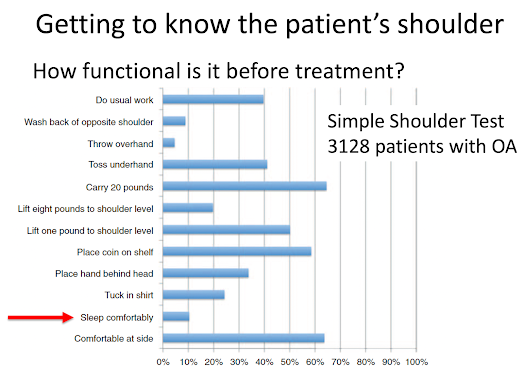Sleeplessness is a prominent complaint of individuals with shoulder arthritis. Shown below are the percentages of the 12 functions of the Simple Shoulder Test that were performable by over 3,000 patients presenting with glenohumeral osteoarthritis. Note that 90% of these patients were unable to sleep comfortably.
The authors of Improvement in Sleep Disturbance Following Anatomic and Reverse Shoulder Arthroplasty used the Simple Shoulder Test and other measures to assess sleep impairment prior to shoulder arthroplasty as well as the recovery of the ability to sleep comfortably after shoulder arthroplasty for glenohumeral arthritis. They identified 1,405 patients treated with shoulder arthroplasty: 698 who underwent anatomic shoulder arthroplasty (TSA) and 707 who underwent reverse total shoulder (RSA). 97%) of those who underwent TSA and 95% of those who underwent RSA reported sleep disturbance prior to surgery.
517 who underwent TSA and 472 who underwent RSA were studied with a median follow-up of 36 months for the TSA group and 25 months for the RSA group.
Postoperatively, significant improvements in the average ability to sleep comfortably and sleep on the affected side were observed in both the TSA group and the RSA group. The ability to sleep comfortably returned faster than the ability to sleep on the affected side, with the ability to sleep comfortably reaching a plateau at 3 months and the ability to sleep on the affected side reaching a plateau at 6 months. Despite improvements in terms of sleep disturbance, at the time of most recent follow-up, 13.2% of patients in the TSA group and 16.0% of those in the RSA group could not sleep comfortably and 31.4% of those in the TSA group and 36.8% of those in the RSA group could not sleep on the operative side.
Comment: This is an informative study. While it answers some clinically important questions, it does not answer the question "why do 1/3 of patients not regain their ability to sleep on the operative side after arthroplasty?" It would be of interest, for example, to know if the shoulders of the "unable to sleep" patients were stiffer than the others. This information could help inform the details of surgery (e.g. how tight the soft tissues should be) and the details of the post operative rehabilitation (e.g. how soon and what type of exercises should be implemented after surgery).
Follow on twitter: https://twitter.com/RickMatsen or https://twitter.com/shoulderarth
Follow on facebook: click on this link
Follow on facebook: https://www.facebook.com/frederick.matsen
Follow on LinkedIn: https://www.linkedin.com/in/rick-matsen-88b1a8133/
Here are some videos that are of shoulder interest
Shoulder arthritis - what you need to know (see this link).
How to x-ray the shoulder (see this link).
The ream and run procedure (see this link).
The total shoulder arthroplasty (see this link).
The cuff tear arthropathy arthroplasty (see this link).
The reverse total shoulder arthroplasty (see this link).
The smooth and move procedure for irreparable rotator cuff tears (see this link).
Shoulder rehabilitation exercises (see this link).



